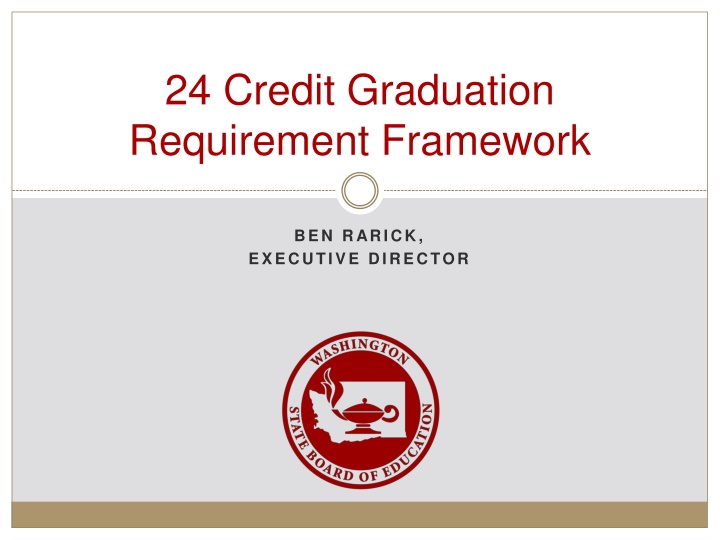
Washington State Graduation Requirements and Pathways
Explore the 24-credit graduation requirement framework in Washington State, focusing on foundational high school course credits, STEM skills, postsecondary pathways, and stakeholder input. Discover the guiding principles, proposed requirements, and available resources to support student success.
Download Presentation

Please find below an Image/Link to download the presentation.
The content on the website is provided AS IS for your information and personal use only. It may not be sold, licensed, or shared on other websites without obtaining consent from the author. If you encounter any issues during the download, it is possible that the publisher has removed the file from their server.
You are allowed to download the files provided on this website for personal or commercial use, subject to the condition that they are used lawfully. All files are the property of their respective owners.
The content on the website is provided AS IS for your information and personal use only. It may not be sold, licensed, or shared on other websites without obtaining consent from the author.
E N D
Presentation Transcript
24 Credit Graduation Requirement Framework BEN RARICK, EXECUTIVE DIRECTOR
Graduation requirement guiding principles All students should earn certain foundational high school course credits to meet the intent of Basic Education. In the 21st century, all students need Science, Technology, Engineering and Math (STEM) skills; 3 credits of math and 3 credits of science are foundational courses credits. High school electives are important, allowing choice in course-taking, providing the opportunity to explore a range of fields of knowledge, and allowing the opportunity to pursue certain postsecondary pathways. Every student should have a High School and Beyond Plan by 9th grade or earlier, upon which all course-taking decisions will be based. All students should be preparing for their life after high school; each student s High School and Beyond Plan should identify a postsecondary pathway. Washington State Board of Education
Postsecondary Pathways Post-secondary pathways are locally determined, but should include, at least, the opportunity to: Attend a skills center or pursue a Career and Technical Education program of study Pursue a certificate or degree in a professional/technical program Pursue a 4-year degree via a college, university, or college transfer program Washington State Board of Education
Stakeholder Input Stakeholder Input Options 24-credit framework crowds out electives. Show general electives as unchanged. CTE pathways need to be incorporated. Create personalized pathway requirements. Change occupational education credit to Career and Technical Education. Make sure students have enough free electives to pursue courses at a skills center. 4 electives + 3 personalized pathway requirements creates a combined 7 available credits. Embrace a broader definition of college to include postsecondary education and training. Use pathways to postsecondary as branding term for requirements. The third credit of science and math make it harder for students to attend skills centers. Develop state models of math and science course equivalencies. Students should get credit for the math and science they take at skills centers. Washington State Board of Education
Previously Proposed Requirements Washington State Board of Education
Currently Proposed Requirements Washington State Board of Education
Resources Website: www.SBE.wa.gov Blog: washingtonSBE.wordpress.com Facebook: www.facebook.com/washingtonSBE Twitter: www.twitter.com/wa_SBE Email: sbe@sbe.wa.gov Phone: 360-725-6025 Washington State Board of Education
